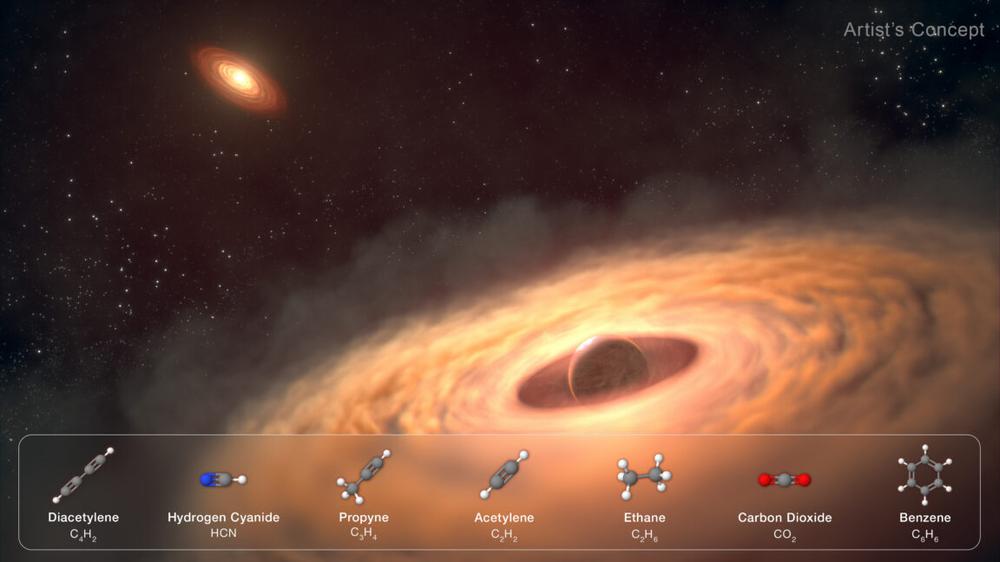Many of the most interesting bodies in our Solar System aren't planets, but the moons that orbit them. They have active volcanoes, hydrocarbon oceans, geysers, and moon-wide oceans buried under icy crusts. And, as far as we can tell, the physics of the processes that produce large planets should make moon formation inevitable. Given how common planets are, our galaxy should be teeming with moons.
Yet, despite some tantalizing hints, we've not found a clear indication of a moon orbiting an exoplanet. What we have found are a few very young exoplanets that appear to have moon-forming disks around them. Now, the James Webb Space Telescope has obtained a spectrum of the ring-forming disk around a giant super-Jupiter, and found that it's rich in small carbon-based molecules. That's despite the fact that the star it's orbiting seems to have a planet-forming disk that's mostly water.
Finding disks
We search for exo-moons and moon-forming disks using completely different methods. To spot an actual moon, we rely on its gravitational influence. At some points in its orbit, it will be towing its planet forward to speed up its orbit; at others, it will be holding its planet back. This introduces subtle variations in the timing of when the planet arrives in front of the star from Earth's perspective.
(The moon should also block out a bit more of the star's light at different points in its orbit, but this can easily be masked by variability in the star itself.)
Moon-forming disks, however, are only present early in an exosolar system's history. They are a bit like larger versions of the rings of Saturn, but with enough material to condense into moons. Over the first few million years of an exosolar system's history, that material will end up as some combination of dispersed, condensed into moons, or fallen into the planet.
Unfortunately, during their (astronomically speaking) short existence, the gravitational influence of these disks on the planet is relatively even, so we can't use that. And they don't emit or reflect enough light to avoid being swamped by the light originating from the star. So, if we're going to find evidence of one, it's going to have to be near a newly formed star, and orbiting a planet that's quite a distance from that star.
Fortunately, we have been able to spot a number of planets that fit these requirements. In fact, all the planets we've imaged directly have been orbiting newborn stars. That's because these planets are still glowing in the infrared from the heat released during their gravitational collapse, making them possible to spot even though they're so far from their host star that they're not reflecting much light. These planets are also giants, generally multiple times the mass of Jupiter, which is why they emit enough infrared to be visible from Earth.
Studies of these planets have suggested that several of them are surrounded by moon-forming disks. But we didn't have much information on the disks themselves until now.
Moons-to-be
That's changed thanks to the incredible resolving power of the JWST. Two astronomers, Gabriele Cugno and Sierra Grant, obtained images from near the star CT Cha, a young Sun-like (0.9 solar masses) star located about 625 light-years away. CT Cha is known to have a companion called CT Cha b, a super-Jupiter with over 15 times the mass of the familiar planet. The massive planet orbits about 15 times further away from its host star than Neptune does from our Sun, making it possible to resolve the planet separately from CT Cha itself.
A first scan of the spectrum in the vicinity of the planet revealed the likely presence of numerous chemicals, including small carbon compounds such as ethane, acetylene, and carbon dioxide. Once they knew what chemicals to look for and where the planet is, Cugno and Grant could perform a relatively simple experiment: set a spectrograph on the JWST so that it was sensitive to the peak emissions of many common molecules, and simply see whether the planet showed up in the image. If it did, those chemicals were present in the neighborhood of the planet.
The two researchers then modeled the emissions of the moon-forming disk, figuring out the list of chemicals that would re-create the observations, as well as the temperatures at which those chemicals were present. Many of these were at temperatures below 250 K, suggesting that they were liberated from icy materials either by sublimation or during collisions, but the acetylene appeared to be noticeably warmer, suggesting that a lot of this material is in the inner portion of the disk closest to the planet.
The striking thing about this is that repeating the procedure on the star turned up no evidence of carbon-based chemicals, even though the system is young enough that it should still have a planet-forming disk. Instead, the primary signal near the star comes from water molecules, which are absent from the moon-forming disk.
Why is all the carbon there?
It's tempting to think that the materials in a planet-forming disk would be evenly mixed, and so the material fed into the moon-forming disk should be the same as the stuff closer in to the star. But things are not nearly that simple. Many materials will freeze into a solid at different distances from the star, and so be present in higher densities outside their individual "snow lines."
In addition, CT Cha b, the planet, is orbiting in a region where there shouldn't be enough material for standard planet formation processes to occur, much less build a giant such as CT Cha b. So, Cugno and Grant infer that it most likely formed by an instability in the disk that formed the star, a process that often produces a binary star system, but can also result in a star orbited by a brown dwarf or giant planet.
An intriguing finding has been that, while Sun-like stars tend to have more water than carbon in their planet-forming disk, while smaller stars and brown dwarfs see the reverse, with lots of carbon and less water. CT Cha b indicates that this pattern extends into the planet-sized bodies. The intrigue comes from the fact that we don't know what produces this pattern; there are a number of hypotheses, not all mutually exclusive, and we haven't figured out how to get a definitive answer yet.
In any case, the big picture isn't exactly a surprise. If our models of planet and star formation are anywhere close to right, then a disk of materials that can form additional bodies is an inevitability. And the high frequency with which we're finding planets orbiting other stars suggests that those models are very accurate. So, we'd fully expected moon-forming disks to be there as well. Still, it's always important to have confirmation that things are actually working as expected, and further studies like this may give us a clearer picture of moon-forming disks that will ultimately allow us to build more sophisticated models and start building a detailed picture of how moons come to be.
The Astrophysical Journal Letters, 2025. DOI: 10.3847/2041-8213/ae0290 (About DOIs).

 A breach every month raises doubts about South Korea’s digital defenses
A breach every month raises doubts about South Korea’s digital defenses